By Pete Vack
There is so much to say about Lancia, and Lancia and De Virgilio: At The Center. Both topics are far too large for the confines of an online magazine so we will try to contain ourselves. But we’ll take a quick look at the book itself and then discuss the Jano/Fessia Lancias and how they differed.
At the Center
Lancia and De Virgilio: At The Center is a large book, 330 pages,11 by 11 ¾ inches, yet just big enough to contain the huge amount of information it stores between the covers. With unprecedented access to the De Virgilio family archives, Lancia enthusiast and architect Geoff Goldberg has given us an insider’s view of the achievements of Francesco De Virgilio, one of the most influential post war Italian automotive engineers.
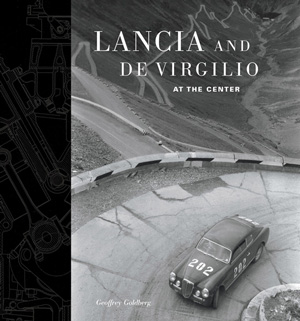 Goldberg does this in a fashion that would do justice to Griff Borgeson, Karl Ludvigsen, and Doug Nye. To properly present this important epic, six years in the making, Goldberg went to high end publisher David Bull (who was able to produce this epic for under a $100 retail price, no small achievement in itself) and obtained their full support as a publisher, ensuring that the book would be produced with the highest quality materials. Offering more support was the REVS Institute, who found many more images from the Ludvigsen/Mailander archives. Miles Collier also wrote the preface, using the opportunity to make the goals of the Revs Institute clear; his enthusiasm for the project ensured that Goldberg’s book is well documented (with ample footnotes, sources, and appendixes) and demonstrates a serious approach to automotive historical research. More importantly, Goldberg achieved and retained the support of the De Virgilio family; a rare honor for an American who according to son Luigi De Virgilio, “…had good knowledge of the European (and Italian) way of thinking and is properly cosmopolitan.”
Goldberg does this in a fashion that would do justice to Griff Borgeson, Karl Ludvigsen, and Doug Nye. To properly present this important epic, six years in the making, Goldberg went to high end publisher David Bull (who was able to produce this epic for under a $100 retail price, no small achievement in itself) and obtained their full support as a publisher, ensuring that the book would be produced with the highest quality materials. Offering more support was the REVS Institute, who found many more images from the Ludvigsen/Mailander archives. Miles Collier also wrote the preface, using the opportunity to make the goals of the Revs Institute clear; his enthusiasm for the project ensured that Goldberg’s book is well documented (with ample footnotes, sources, and appendixes) and demonstrates a serious approach to automotive historical research. More importantly, Goldberg achieved and retained the support of the De Virgilio family; a rare honor for an American who according to son Luigi De Virgilio, “…had good knowledge of the European (and Italian) way of thinking and is properly cosmopolitan.”
Nigel Trow’s review (link) pays tribute to Goldberg’s effort. For my part, I would only add that At the Center is one of the best books we have read this year. I have never read anything quite like it. Four thumbs up.
The Great Divide
Francesco De Virgilio was not only ‘at the center’ but in the middle of the great divide between the Jano years and the Professor Antonio Fessia era, a transition that De Virgilio survived but not entirely happily. Goldberg explains these years in detail, for even though De Virgilio’s role was lessened under Fessia, he continued on until 1975, well after the Fiat takeover, designing truck engines, with an occasionally foray into the Fulvia and Stratos programs.
As a Lancia owner and enthusiast in the 1970s and 80s, I was lucky enough to have owned or driven Lancias designed under the Jano/De Virgilio era as well the post-1955 Fessia years. To have dismantled, nut by brass nut, a ‘lowly’ Appia sedan was a revelation; to delve into the intricacies of the Appia head and narrow angle V4 was to unveil the geniuses of Jano, De Virgilio and according to Goldberg, Cesare Mulazzani . My fellow Americans, steeped in the mighty roughhewn wide angle iron block V8s were always amazed at the brilliant engineering and aluminum castings of the tiny V4. De Virgilio owned and drove an Appia on a daily basis. But Lancias were rare in America. Reliable engines suffered under questionable electrics and they often rusted early.
The Appia was followed a few years later by a Lancia Flavia Zagato, Fessia’s front wheel drive flat four fabrication* for the post-Lancia family, post-Jano, post-De Virgilio era all of which ended abruptly in 1955.
To the Moon
Connecting this sudden flurry of Lancia enthusiasm, in the center of a unique sect of hyper-intelligent petrol heads, was often Howard Moon. He met with Nigel Trow in the UK, he knew Geoff Goldberg, and Carter Hendricks, (Goldberg recalls that “Back in college I bought a white RHD B20 from Howard Moon, and drove it for a bit. Not understanding its deep virtues, I sold it to Carter Hendricks, who still has it!) Lancia doyen Armand Giglio, and owned at various times an Aurelia Convertible, two B20s, a rare Stablimenti Farina-bodied Aurelia, several B10s, and a charming blue Aprilia coupe, and several Flavias, all kept in various states of disrepair behind his house in the rapidly-getting-fashionable and expensive area of Falls Church, VA. (That well-to-do upscalers moved into old houses in his ancient neighborhood was sure to bode ill for Moon; for Washington area residents the old saw ‘one man’s treasure is another man’s garbage’ was never so true, works of engineering genius or not. Carroll Shelby once said that there were two cities in the U.S. that were anti-automobile and Washington was the first.)
Moon was good friend of Tom Stewart Sr., (who owned more Lancias than Howard, but little else. Stewart, as I recall, aside from the famed Ferrari Mexico S/N 0224, never owned anything but Lancias, all hidden away in a shed behind an Addams Family- like house near a tiny hamlet in Northern Virginia.) It was also Moon who deftly edited the Lanciana newsletters, today offered for sale again by Steve Snyder (https://velocetoday.com/lanciana-and-friends/) As a mere trifle along the way while working for the CIA, Moon wrote Soviet SST: The Technopolitics of the Tupolev-144. the untold story of the Tupolev Tu-144 Russian supersonsic transport jet.

Lancias were handled in the U.S. by Hoffman Motors on the East Coast. But even the Series III was not a huge seller.
It was Moon’s truly groundbreaking De Virgilio Lancia B20 that I had occasion to drive on several occasions, therefore allowing me to experience firsthand the V4, V6, and the Fessia flat four Lancias that were the mainstays of the Lancia line from 1950 to 1970. Like Ferraris of the 50s and the Porsche 356 series, pre-Fiat Lancias were imbued with a cornucopia of engineering personality. But Lancia trumped them all, as the Ferrari’s engineering virtuosity ended at the flywheel while the truly different Porsche was made mundane by the closely related Volkswagen. Neither Ferrari production cars nor Alfa Romeo came close to the Aurelia’s chassis until the mid and late 1960s.
The differences, of course were dramatic; the Aurelia drove willingly and one could feel that rear end shifting and moving while the tires retained their grip and the clutch took hold. Forward, the V6 was the smoothest thing around until the Alfa V6, also inspired by De Virgilio, and had a sound and feel of small power, for 2.5 liters did not exactly overwhelm the weight. As modern as could be, it had a very vintage feel, probably due to the steering and front suspension.
The Appia was more fun to work on than drive, thirsty for more power and yet such an incredible jewel. The rear drive conventional chassis was more predictable but less exciting; even the Zagato lacked the performance the design promised. Yet put together with love and care and rationality, and at a great cost.
Fessia’s Flavia was a totally different story, with no links to the distant or near past, it was Fessia’s engineering dream come true since his days at CEMSA (see below) but was also ponderous, heavy, and drove nothing like earlier Lancias. The badge still said Lancia, but one wondered if the same language was being used. The 1800 cc flat four was no masterpiece, and the front drive uncomfortable. That is not to say it was not a good car; it was, in fact a fine car, but was it a Lancia?
Of the Flaminia, we never owned or drove one; an improved, though some might say not, Aurelia upgraded by the Fessia staff until not one part was interchangeable with the old Aurelia. Refinement without passion, but that is a comment without background.
What then of the Fulvia? Should I live long enough for the prices to come down again (did that once, may not make it for second round though), I should like to buy a Fulvia, a road worthy 1600 perhaps. Was this the ideal Lancia? A nearly perfect in-house body (although somewhat dated to the early 60s), Fessia’s front wheel drive mated to the narrow angle V4, penned by Ettore Zaccone Mina, and the the last iteration of the Lancia/Jano/De Virgilio/Mulazanni engineering achievement?
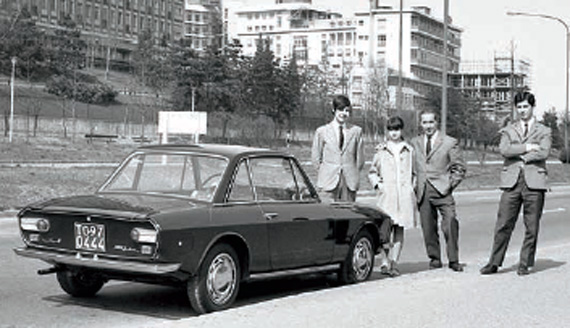
The De Virgilio family with the new Fulvia coupe in 1968. Photo from 'Lancia and De Virgilio, At The Center.'
Was this the last real Lancia? Or perhaps the last real Lancia was the Flavia PF 2000 coupe, one of which is now owned by the aforementioned Howard Moon. This is assuming one considers the Flavias to be real Lancias in the first place. We’ll let the real Lancistis toss this one about.
Back to the beginning. Lancia and De Virgilio: At the Center allows us to better understand and appreciate the Lancias we owned and appreciated; to gain insight into the brilliant engineering work of De Virgilio that made the V6 possible and therefore the entire Aurelia concept; to understand, at least on some level, the passions, personal life and complexities of Italian industrialists, engineering and designers in the mid twentieth century. Buy a copy now: It is the best book on Italian cars this year.
*Fessia and the Caproni
Antonio Fessia was responsible for the design of the Caproni Cemsa that was first shown in 1947 at the Turin Autosalon.
Fessia’s 1100 cc Cemsa (Caproni Elettro Meccanica Societa Anonima) Caproni was an unsuccessful attempt by the famous Italian airplane builder to enter Italy’s post war car market. The Cemsa Caproni was built in the town of Saronno, the place of origin of the famous Lazzaroni Amaretto cookies and the liqueur that goes by the same name.
The Cemsa Capronis are in all ways and means to be regarded as the predecessors of the Flavia. The body was designed, and perhaps constructed by Bertone. Only two Cemsa Capronis still exist in Italy; both cars are rumored to be owned by a member of the Caproni family. The whereabouts of other Cemsas (if any at all) is unknown as of today.
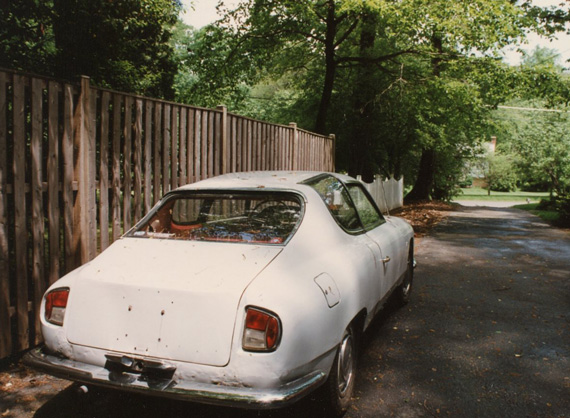
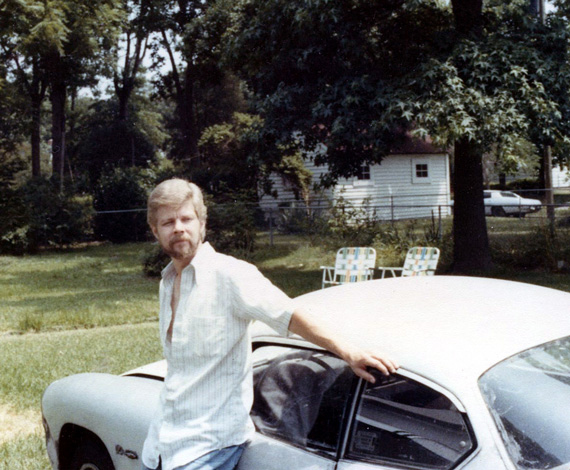
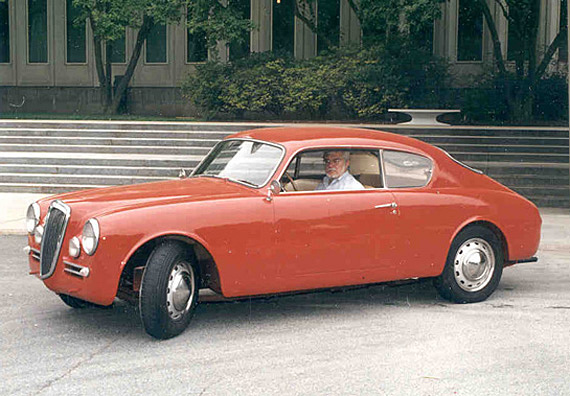
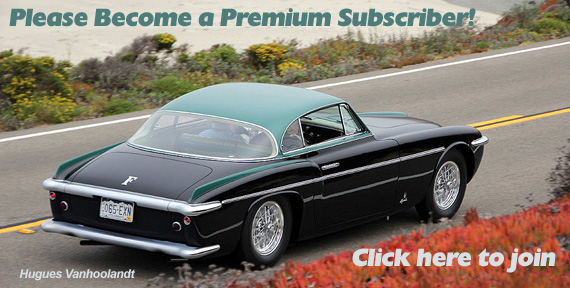
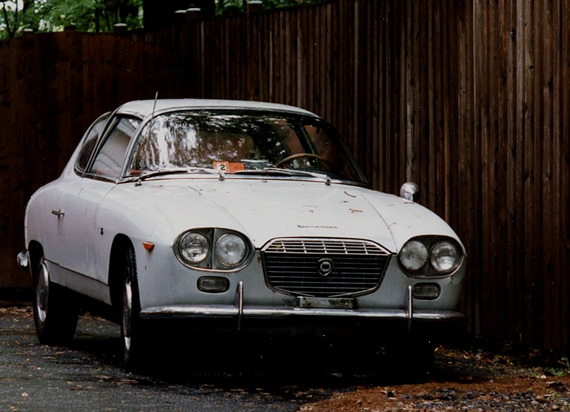

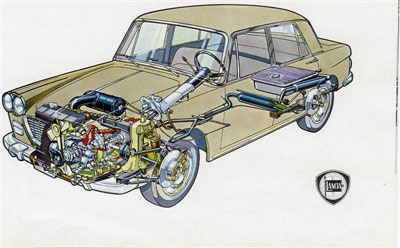
“The Fulvia – with a near perfect body by Pininfarina”. Perhaps I’ve misunderstood what you are saying but the coupe was designed inhouse by Piero Castagnero. I think it’s one of the most beautiful cars ever, but I’m biased as I have a 1.3S.
Stanley,
Oops…you are correct of course and my mistake is now fixed. Let me know if you want to sell your Fulvia!
Editor
As another 1.3s owner I have to agree it’s a near perfect design. Every time I pull it out of the garage I find another line to admire and this after owning it for 12 years!
The De Virgilio book is fantastic, too bad Aurelia’s are now out of reach for me. Time to start hunting for an Appia.
I had the privilege to meet Geoff Goldberg at his book signing in Chicago a week ago and then to have breakfast with him the next morning before driving my “just a V6” VW R32 back home to Minneapolis. An outstanding book in every sense. A privilege indeed. Goldberg is instantly to be elevated into the “automotive historian hall of fame” with the likes of Doug Nye and Nigel Trow, both of whom I know.
I, too, am besotted by Lancia…on the Pebble Beach Tour this year was a factory prototype Lancia Falviasport Zagato in bright red paint reminding me of my visit to the 1964 Snetterton round of the European Touring Car Championship where Umberto Maglioli drove a factory production race car, then in a maroon red. My memory wavered as I recalled a hitchhiking trip out of London when a black Flaviasport stopped wanting to go to a language school in Cambridge. That was a crazy drive home with said Italian driver asking me if it was his turn at each traffic light. What were the colors for I thought at the time! Oh, and then my own Lancia Beta HPE 2000 IE. I bought it new and sold it within six months a wreck. Lovely to drive, horrible to maintain. Oil leaked from every orifice, joint, seal, filler cap, oil pan drain. Oh my what a waste! Then there was the factory Stratos at Donington during a pit stop on the RAC Rally which demanded each spark plug to be changed. You can well imagine that was not so quick, but there was a lot of shouting from team manager, mechanic and driver alike. Fun for the spectator, though.
Buy this book, it’s wonderful.
Pete, I just started Geoff’s new book, I’m impressed with the factual detail and the photos.. I’m recently back in the Lancia family with a B24S, the mechanical design and attention to details make it a better driving car then any Ferrari I have experienced…
Pete –
Thanks for the kind words and glad you enjoyed the book. Fun revisiting old friends through your stories, although I think you are too hard on Flavias. They have their own charm, as does every Lancia. The debate of “is it or isn’t it?” started after the death of Vincenzo, and the use of the “wide angle” V6 in the Aurelia (60º being more than any Lancia before that). It continued to the Flaminia (no sliding pillar), then to the FWD Flavia, but seems to have rescinded with the ever-popular Fulvia. It emerged again in the ’70s with the Beta (Fiat block, albeit heavily reworked), but success with the Delta seemed to help. Then again, these were the debates of long ago, and now…. enjoyment of any period Lancia (including Flavias) is a treat. They have their charms, each one, up to…..
It would be hard to deny the Fulvia series an entry into the “it is” category. One look at the powertrain subframe sitting alone is enough to insure it’s entry. Motorsports victories on the tarmac (Daytona and Sebring) and WRC confirm the Vincenzo Lancia heritage in the purest way.
I have four Lancias; a 1936 Augusta (Taxio Nuvolari loved his) think MG TC with four doors and independent front suspension, a 1951 Aurelia B21 (imported by General Motors) taken apart and analysed, it inspired them to pioneer the V6 engine on this side of the pond (bought with low miles because some idiot tore out low gear), (I assembled it with taller gearing for American highways). a 1963 Fulvia berlina (the 406th Fulvia made) purchased in 1975 with 28k on the clock, a lovely little car, Originally with single carb 1100 cc engine, after putting more than 50K miles on it stock, I have installed a 1300 cc engine with the original single carbie, and a five-speed box, retaining the column shift, 15 inch Flavia wheels improve the ride and gearing. and finally a 1.8 Flavia Vignale convertible (only a few pounds heavier than a Fulvia on essentially the same running gear). Many people agree that Lancia never made a bad car. I go along with that, with the possible exception of the di-Alpha model. They just (in the early teens) added two more cylinders to their four cylinder Alpha model. Crankshaft torsional vibration was not understood at the time and it probably suffered the same miseries as other pioneering straight sixes.
Anyway Lancias are addictively wonderful to own and drive.
Bill Stebbins
I own a lancia fulvia 1.3s rallye .1969
I have been fortunate to have owned a Ferrari 328. 355. And some 911s and some other famous Italian brands.
This little gem gives me more pleasure than any of the cars I have owned before.
I fell in love with the shape first but was not prepared for how beautiful the engine is made along with all the other details, every day this car does not fail to give me pleasure and it’s up against some strong competition.
I would recommend any lancia fulvia but one should be looking at the pre fiat cars if they really want the full lancia experience.
Marco
I full agree. Of the many cars I’ve been lucky enough to own, I never had a Fulvia and would still like to own one someday. They are wonderful cars and the design is superb.
The Editor…
Well Pete.
All i can tell you is that in the autumn of my life i finally find my true love, she never fails to keep me ready and waiting for the next drive and evey time i go out with her its a different experience. Get one now as soon as you can but it has to be pre fiat and pure Lancia= pure passion.
Do it.